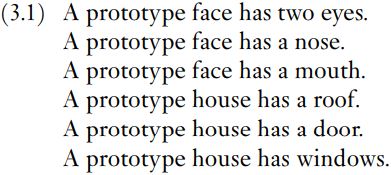


 Grammar
Grammar
 Tenses
Tenses
 Present
Present
 Past
Past
 Future
Future
 Parts Of Speech
Parts Of Speech
 Nouns
Nouns
 Verbs
Verbs
 Adverbs
Adverbs
 Adjectives
Adjectives
 Pronouns
Pronouns
 Pre Position
Pre Position
 Preposition by function
Preposition by function 
 Preposition by construction
Preposition by construction
 Conjunctions
Conjunctions
 Interjections
Interjections
 Grammar Rules
Grammar Rules
 Linguistics
Linguistics
 Semantics
Semantics
 Pragmatics
Pragmatics
 Reading Comprehension
Reading Comprehension|
Read More
Date: 2023-10-19
Date: 2024-07-12
Date: 2024-08-25
|
The has-relation
The everyday words square, circle and triangle are also technical terms in geometry, where they have tight definitions. For example, a closed, straight-sided figure is a triangle if, and only if, it has exactly three sides. This underpins entailments such as: That figure is a triangle ⇒ That figure has three sides. For many words, however, we can only be sure that all the parts are there if the has-relation is stated in terms of prototypes. Prototypes are clear, central members of the denotation of a word.
Think of what you might advise a child drawing a face to put in: probably eyes, a nose and a mouth. How about a child drawing a house?
Probably you would expect there to be a roof, a door (or doors) and windows. Prototypes among the things denoted by the English word face have eyes, a nose and a mouth. The face of a Cyclops, with its single eye, is a face, but it is not a prototype face. I have seen a windowless house (the Black House of Arnol, on the Isle of Lewis). It is incontestably a house, but it is not a prototype for the denotation of house in contemporary English. The information that needs to be built into meaning postulates to reflect these semantic facts is listed in (3.1).

I grant that prototype faces and houses may have other parts besides those listed in (3.1), for example cheeks and a chin (for faces), perhaps a bedroom and kitchen (for houses). I have merely tried to list the main ones. Importantly, there are also many things that the prototypes do not have, like blemishes and a carport, even though these may be parts of many real faces and houses, respectively.
Restricted to prototypes, the has-relation makes available entailments. Some examples are given in (3.2).

Entailments were introduced as guarantees. Here the guarantees are weakened by making them conditional on prototypicality. The entailed propositions in (3.2) start with ‘if ’ because it seems that average English words are not as tightly defined as technical words like triangle. Given that the has-relation has to be restricted to prototypes for some words, it simplifies matters to do the same for all words that enter this relation.
|
|
|
|
5 علامات تحذيرية قد تدل على "مشكل خطير" في الكبد
|
|
|
|
|
|
|
لحماية التراث الوطني.. العتبة العباسية تعلن عن ترميم أكثر من 200 وثيقة خلال عام 2024
|
|
|